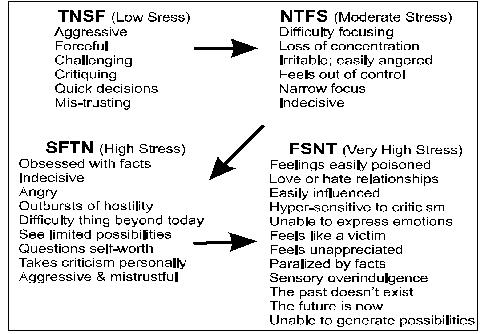Henry L. Thompson, Ph.D.
(The Bulletin of Psychological Type, Winter, 1997)
Recently, I co-presented with Sarah Sharman (Bay Area APT chapter president) at the Professional and Personal Coaches Association's (PPCA) national conference in Atlanta . Our presentation, "Communication Styles Under Stress: Coaching Techniques Using Jung's Typology," was designed to help coaches improve their communication effectiveness during coaching sessions. What follows is a brief summary of the main points.
One of the most important factors in a coaching relationship is effective communication between the coach and the client. This requires both to communicate in the same "type" language. Research (Thompson, 1995, 1996, 1997) indicates that people tend to communicate using one of four languages (S, N, T & F) and/or one of eight dialects--a combination of the primary and secondary languages (TN, NT, ST, TS, SF, FS, NF & FN). For example, an ENTJ normally communicates using the Thinking language and/or the Thinking-iNtuiting dialect. Most people can switch rather easily between their primary and secondary languages. Thus, it is important for the coach to listen carefully and determine which language the client is using, then match the client's language.
In Beside Ourselves, Naomi Quenk (1993) makes the case that during periods of extreme stress the inferior function takes control of consciousness and results in a person exhibiting uncharacteristic, childish, immature and archaic behavior. Quenk's model does not address the impact of stress at less than extreme levels. The Kirby and Barger (1996) model suggests that the inferior function does not take control but, rather, the person attempts to use the dominant function more adamantly as stress increases. They state that the greater the stress, the greater the effort to utilize the dominant function, which eventually results in a dysfunctional state. The stress model presented by Ware, et. al., (1994) suggests that under stress, type preferences migrate toward I, S and T.

Figure 1
"Grip" Meter
My research and anecdotal evidence over the past 12 years using The CommunicationWheel and a systems model of typology suggests that as stress increases, the auxiliary, tertiary and fourth functions tend to rotate into consciousness in a sequential manner (see Figure 1). That is, at moderate levels of stress a low-level, stressed-out version of the auxiliary moves into consciousness. At high levels of stress, a moderately stressed-out version of the tertiary function moves into consciousness. If the stress increases to an extreme level, the fourth function will manifest as the inferior function, resulting in the appearance of a person's "evil twin, Skippy."
In the coach-client relationship, there are at least three significant implications of this sequential stress model. The first is that recognizing the stressed-out forms of the functions through the manifestation of the languages used by clients indicates to the coach the level of stress a client may be experiencing.
The second implication is that if the client's language change is due to stress rather than a conscious choice, it becomes even more important for the coach to match the client's language because of the client's stress-induced hypersensitivity. The stressed client tends to be more sensitive to the language context, is easily angered and experiences tunnel vision (Quenk, 1993).
Thirdly, being aware that the client is speaking a "stressed-out" language enables the coach to use the appropriate intervention of leading the client to a lower stress level. For example, if an ENTJ (who normally speaks the TN dialect) is speaking a stressed-out version of the Sensing language, the coach should begin talking to the client using the Sensing (tertiary) language and attempt to transition the client to iNtuiting (auxiliary) and, eventually, to Thinking (dominant and primary language).

Figure 2
ENTJ sequence
Professional coaching as defined by the PPCA is "an ongoing relationship which focuses on the client taking action toward the realization of their vision, goals or desires" using "a process of inquiry and discovery" to provide the client with "structure, support and feedback." Psychological type, particularly as measured by the MBTI, provides a valuable tool for the coach to use with clients.
The language/stress model presented above, is effective with clients at all organizational levels. The implications of this model for coaches are:
- When you hear a client's third and fourth languages, a red flag should go up
- Coach in the language you hear the client speaking
- Lead the client sequentially back to his/her primary language
References
Barger, N. & Kirby, L. (1997). The Challenge of Change in Organizations. Palo Alto , CA : Davies-Black Publishing.
Quenk, N. (1993). Beside Ourselves. Palo Alto , CA : Consulting Psychologists Press Books.
Thompson, H. (1995).The CommunicationWheel: A Resource Book. Watkinsville , GA : High Performing Systems, Inc.
Thompson, H. (1996).Jung's Function-Attitudes Explained. Watkinsville , GA : Wormhole Publishing.
Thompson, H. (1997).Type Languages, Dialects and Styles. Bulletin of Psychological Type, 20, 2, 37-38.
Ware, J., Rytting, M. & Jenkins, D. (1994). The Effect of Stress on MBTI Scores. Journal of Psychological Type, 30, 39-44.
© 1997-2006 Henry L. Thompson, Ph.D.
|
